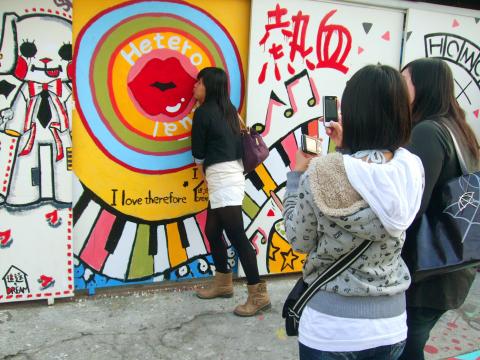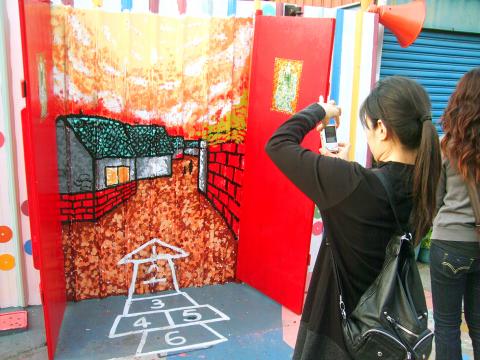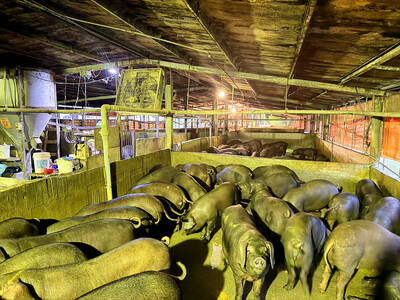Nowadays, if you ask young people in Kaohsiung where they like to go, you might be surprised. Apparently the latest “in” place to go is the Zih Jhu Military Dependants’ Village in Zuoying, to stroll around looking at the wall paintings and installation art there.
Word spread on the Internet, and it is now as well known as the Rainbow Military Dependents’ Village in Greater Taichung. During the four-day Tomb Sweeping Day vacation, students flocked in from all around the country. It was estimated that there were thousands of visitors to the village every day, making it almost as popular as the Pier-2 Art Center. People joke that you won’t get lost there, and in fact you’re more likely to get stuck in traffic.
There are still people living in the village. The sound of motorcycles roaring past and the excited shouts of teenagers taking photos around the village is disturbing the locals. Angered by the noise, the residents have taken to putting up signs saying “keep the noise down or keep away.”

Photo: Ke You-hao, Liberty Times
照片:自由時報記者葛祐豪
All this began last summer vacation when Chung Hui-jung and Huang Hsin-ying, two graduates from Wenzao Ursuline College of Languages, came to the village and lost their way. They ran into a security guard and asked him if it were ok to paint on the walls. He told them they could paint as much as they wanted, as the place was going to be torn down anyway. And that’s how it all got started.
The two girls then brought paint and improvised. They wrote about it on their blog and on Facebook, and it gradually developed a following. Students from the nearby Kaohsiung Municipal Haicing Vocational High School of Technology and Commerce joined in and started to paint the walls in the village.
The continuous flow of youngsters may have disturbed some old people’s afternoon sleep, but it also brought unexpected business opportunities to the village’s few remaining shops. The owner of a popular shop selling crispy rolls, outside which there was a long queue of customers, said that he had never seen so many young people in the village.
(LIBERTY TIMES, TRANSLATED BY TAIJING WU)
時下年輕人最夯的高雄景點在哪?答案可能跌破一堆人眼鏡,竟是左營自助新村的牆壁彩繪與裝置藝術「眷村裡迷路」。

Photo: Ke You-hao, Liberty Times
照片:自由時報記者葛祐豪
透過網路流傳,「眷村裡迷路」最近爆紅,名氣不輸台中彩虹眷村。四天清明連假,外地的學生族群慕名而來,估計每天來往的人潮至少數千人,人氣直逼駁二藝術特區,有人揶揄說「眷村裡不會迷路,但是會塞車!」
不過,自助新村目前仍有住戶,機車呼嘯而過,加上年輕人拍照時的興奮叫鬧聲,已打擾到住戶生活,氣得開始掛起「請大家輕聲細語,違者滾出去」的抗議看板。
故事的緣起是去年暑假,文藻外語學院畢業生鍾慧蓉、黃馨瑩來到自助新村,在眷村裡迷了路,遇到當地的管區員警問說:「我們可以在這裡畫畫嗎?」員警阿莎力回答:「反正這裡要拆了,儘管畫吧!」就這樣,意外開啟這段美麗的機緣。
兩名大女孩搬來油漆,開始即興彩繪創作,透過部落格和臉書,逐漸吸引年輕人目光,隔壁海青工商學生也加入行列,在眷村牆壁上塗鴉創作。
年輕人絡繹不絕,確實影響了一些老伯伯的午睡,但也為眷村裡僅剩的幾家商店帶來意外商機,一家知名的脆皮捲餅,門口排了幾十公尺長的人龍,老闆說,從沒看過自助新村湧入這麼多年輕人。
(自由時報記者葛祐豪)

For many people in Taiwan, childhood memories of rural life include pig pens standing beside family homes. Leftover rice, vegetable scraps and soup from daily meals were poured into buckets and fed to pigs. This practice of feeding pigs with household food waste was once a common way of life, both an economic choice and an expression of agricultural society’s deep respect for conserving resources. From a practical standpoint, pigs are omnivorous animals capable of efficiently digesting food scraps that humans can no longer eat. For rural households, food waste cost almost nothing, yet it could be converted into pork, a

A: Apart from the world’s major dictionaries, the online Dictionary.com actually picked “67” as its word of the year. B: What does “67” even mean? A: Even the dictionary wasn’t exactly sure about its meaning. The slang term’s origin might be traced to US rapper Skrilla’s song Doot Doot (67). Aren’t Taiwanese media outlets choosing the Mandarin word for 2025? B: Yeah and after hearing the song Good-for-Nothing, adapted from some catchphrases of Legislator Wang Shih-chien, I’m going to vote for the character “tsung” (hasty) from the lyrics. A: Hopefully, in the new year, we’ll be calm as the

Sea star wasting disease (SSWD) is a strange and serious illness affecting sea stars, or starfish. This disease causes sea stars to develop painful lesions, lose their arms, and eventually turn into a gooey, melted mess. Since it was first observed in 2013, millions of sea stars along the Pacific coast of North America have died from this __1__. Although viruses were once considered a possible cause, researchers now believe that environmental stressors and microorganisms are primarily __2__ for sea star wasting disease. One of the main environmental triggers appears to be warmer ocean water. When the water heats

Continued from yesterday(延續自昨日) https://www.taipeitimes.com/News/lang The loss of sea stars significantly impacts the ocean ecosystem. Sea stars are important __6__ that help control populations of mussels and sea urchins. Among them, the sunflower star is one of the largest and fastest sea stars and is adept at preying on sea urchins. Without sea stars, sea urchins can __7__ in numbers and devastate kelp forests. These forests are essential __8__ for many marine animals and also help capture carbon from the atmosphere, which is vital in the fight against climate change. The mystery behind SSWD is still __9__, but it is clear that